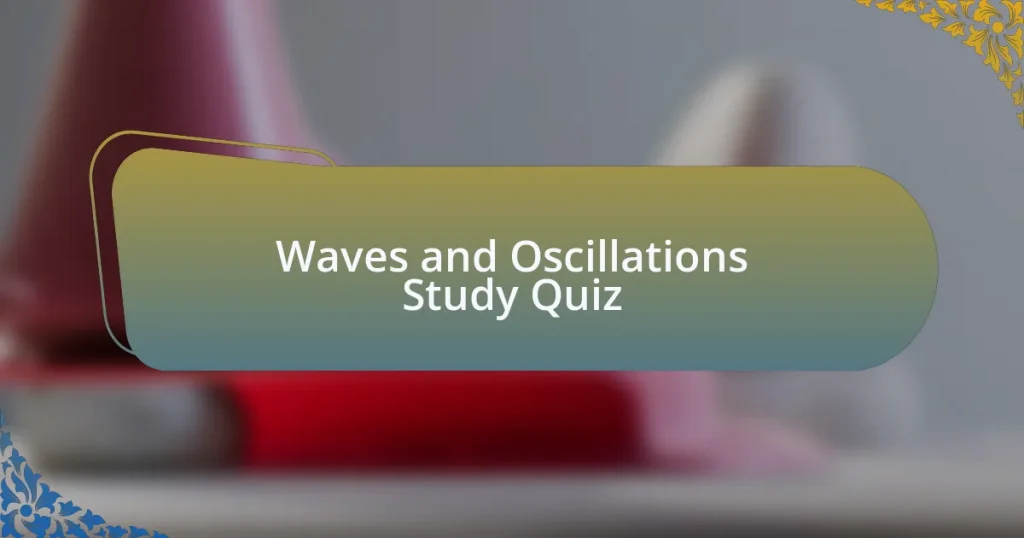Start of Thermodynamics Key Concepts Quiz
1. Which branch of science do the laws of thermodynamics primarily apply to?
- Chemistry
- Engineering
- Biology
- Physics
2. What do the laws of thermodynamics establish relationships between?
- Thermodynamic processes
- Chemical reactions
- Electromagnetic waves
- Quantum states
3. What do the laws of thermodynamics define?
- Chemical reactions
- Electrical circuits
- Physical quantities
- Mechanical systems
4. How many fundamental laws of thermodynamics are traditionally recognized?
- Five
- Three
- Four
- Six
5. What does the zeroth law of thermodynamics define?
- Entropy measurement
- Energy conservation
- Absolute pressure
- Thermal equilibrium
6. Which physical quantities are characterized by the laws of thermodynamics?
- Volume, pressure, and wavelength
- Speed, force, and mass
- Distance, time, and power
- Energy, entropy, and temperature
7. What do the laws of thermodynamics preclude the possibility of?
- Perpetual motion machines and spontaneous transfer of heat from a colder body to a hotter body
- Creation of energy from nothing
- Total energy conservation in isolated systems
- Energy efficiency under all conditions
8. In addition to thermodynamics, where else are the laws of thermodynamics applicable?
- Psychology
- Sociology
- Chemistry
- Geology
9. Which law of thermodynamics was recognized as the most fundamental after the first three laws had been established?
- The first law
- The third law
- The zeroth law
- The second law
10. What is the zeroth law of thermodynamics primarily concerned with?
- The energy transfer between systems
- The concept of temperature and its measurement
- The calculation of work done in a system
- The behavior of gases under pressure
11. What is the formula for enthalpy?
- H = E – PV
- H = E + PV
- H = P + V
- H = U + T
12. What is the formula for Gibbs free energy?
- G = PV – TS
- G = U + PV + TS
- G = U + TS
- G = U + PV – TS
13. What is the formula for Helmholtz free energy?
- F = U – PV
- F = U + TS
- F = TS + PV
- F = U – TS
14. In which law of thermodynamics is entropy defined?
- The second law
- The first law
- The third law
- The zeroth law
15. What is an adiabatic process?
- A process where pressure remains constant
- A process where volume does not change
- A process where no heat transfer occurs
- A process where temperature remains the same
16. What is an isochoric process?
- A process where pressure remains constant
- A process where heat is exchanged
- A process where no volume change occurs
- A process where temperature remains constant
17. What is an isobaric process?
- A process where no temperature change occurs
- A process where no pressure change occurs
- A process where no volume change occurs
- A process where no heat transfer occurs
18. What is an isothermal process?
- A process that occurs with no heat transfer
- A process where volume remains constant
- A process that occurs at constant pressure
- A process where no temperature change occurs
19. Who coined the term thermodynamics?
- Albert Einstein
- Richard Feynman
- James Clerk Maxwell
- William Thomson
20. What are thermodynamic potentials?
- The energy required to change the state of matter
- Quantitative measures of stored energy in a system
- Measurements of particle motion in a gas
- The rate of heat transfer in a process
21. According to the third law of thermodynamics, what happens to the entropy of a system as the temperature approaches absolute zero?
- It increases indefinitely
- It approaches negative infinity
- It approaches a constant value
- It becomes zero
22. What are the branches of thermodynamics?
- Relativistic thermodynamics, wave thermodynamics, particle thermodynamics, and classical dynamics
- Classical thermodynamics, statistical thermodynamics, chemical thermodynamics, and equilibrium thermodynamics
- Quantum thermodynamics, electrothermodynamics, magnetothermal dynamics, and fluid thermodynamics
- Mechanical thermodynamics, thermoelectric thermodynamics, chemical dynamics, and fluid mechanics
23. What happens to a thermodynamic system undergoing changes in pressure, volume, and internal energy?
- It only changes volume
- It remains unchanged
- It undergoes all these changes
- It only changes pressure
24. What is the measurement of energy in a thermodynamic system referred to as?
- Temperature
- Pressure
- Entropy
- Enthalpy
25. What is the formula for internal energy?
- U = 1/2 mv^2
- U = PV
- U=∫TdS−PdV+∑iμidNi
- U = mgh
26. What is the relationship between Cp and Cv?
- Cp + Cv = R
- Cp x Cv = R
- Cp – Cv = R
- Cp / Cv = R
27. Under what conditions is the heat evolved or absorbed equal to the internal energy change?
- At high temperatures
- At constant pressure
- At constant temperature
- At constant volume
28. Why is the enthalpy of neutralization of HF greater than 57.1 kJ mol–1?
- It is because of strong ionic interactions with water
- Due to high hydration energy of fluoride ions
- It is due to lower bond strength in HF
- It results from the high temperature of the reaction
29. Define a cyclic process.
- A single process that continues indefinitely
- A series of processes ending with the system in the same state as it began
- A process where heat is always added to the system
- A process that maintains constant pressure only
30. Name two intensive and extensive properties of a system.
- Volume and radius
- Density and time
- Temperature and energy
- Viscosity and mass
Congratulations on Completing the Quiz!
You’ve successfully navigated through the quiz on ‘Thermodynamics Key Concepts.’ Whether you found the questions challenging or straightforward, you’ve taken an important step in reinforcing your understanding of thermodynamics. This topic is fundamental in physics, impacting everything from engines to refrigerators. Engaging with these concepts can deepen your comprehension and bolster your confidence in the subject.
Throughout this quiz, you’ve likely sharpened your skills on crucial thermodynamic principles. Concepts such as the laws of thermodynamics, entropy, and energy transfer are not just theoretical. They are essential for problem-solving in various real-world applications. By grasping these key ideas, you’re better equipped for advanced studies in physics and related fields. Every question helped clarify your knowledge and highlight areas for further exploration.
Now that you’ve completed the quiz, we invite you to expand your understanding even further. Check out the next section on this page dedicated to ‘Thermodynamics Key Concepts.’ Here, you’ll find valuable resources and detailed explanations designed to enhance your study process. Let’s dive deeper into this essential aspect of physics together and keep the learning momentum going!
Thermodynamics Key Concepts
Introduction to Thermodynamics
Thermodynamics is the branch of physics that deals with heat, work, temperature, and energy. It studies how energy is transferred between systems and how it influences the physical properties of matter. The laws of thermodynamics provide fundamental principles guiding these processes, making them essential for understanding physical and chemical changes.
First Law of Thermodynamics
The First Law of Thermodynamics states that energy cannot be created or destroyed, only transformed. This law introduces the concept of internal energy, whereby the change in a system’s internal energy equals the heat added to the system minus the work done by the system. It helps in quantifying energy transfers in physical processes, ensuring energy conservation in isolated systems.
Second Law of Thermodynamics
The Second Law of Thermodynamics asserts that the entropy of an isolated system never decreases over time. Entropy is a measure of disorder or randomness. This law implies that natural processes favor a direction that increases total entropy, impacting efficiency in energy conversion and dictating the feasibility of thermodynamic processes, such as heat engines.
Thermodynamic Processes
Thermodynamic processes are transitions between different states of a system, classified into types such as isothermal, adiabatic, isochoric, and isobaric. Each process has distinct characteristics. For example, isothermal processes occur at constant temperature, while adiabatic processes involve no heat exchange. Understanding these processes is critical for solving problems in thermal systems.
Applications of Thermodynamics
Thermodynamics has vast applications across various fields, including engineering, chemistry, and environmental science. It governs the operation of heat engines, refrigerators, and various industrial processes. Moreover, it aids in understanding natural phenomena, such as climate change and energy resources, emphasizing its importance in practical scenarios and scientific research.
What are the main laws of thermodynamics?
The main laws of thermodynamics are the zeroth, first, second, and third laws. The zeroth law states that if two systems are in thermal equilibrium with a third system, they are in thermal equilibrium with each other. The first law, also known as the law of energy conservation, states that energy cannot be created or destroyed, only transformed. The second law establishes that in any energy exchange, if no energy enters or leaves the system, the potential energy will always be less than the initial energy. The third law states that as the temperature of a system approaches absolute zero, the entropy approaches a constant minimum.
How is temperature related to thermodynamics?
Temperature is a measure of the average kinetic energy of particles in a substance and plays a crucial role in thermodynamics. It determines the direction of heat transfer between two systems. Heat will flow from a higher temperature region to a lower temperature region until thermal equilibrium is reached, as explained by the second law of thermodynamics. For example, in a heat engine, temperature differences between the heat source and sink drive the conversion of heat energy into work.
Where are thermodynamic processes commonly applied?
Thermodynamic processes are commonly applied in various fields, particularly in engineering, environmental science, and chemistry. For example, they are used in designing engines, refrigerators, and heat pumps. Power plants utilize thermodynamic principles to convert heat energy into mechanical energy for electricity generation. In addition, understanding thermodynamics is essential in processes like chemical reactions, where temperature and pressure significantly affect reaction rates and equilibria.
When did thermodynamics emerge as a scientific discipline?
Thermodynamics emerged as a scientific discipline in the mid-19th century. The foundational principles were developed through the work of scientists like Sadi Carnot, Rudolf Clausius, and Lord Kelvin. Carnot published his seminal work in 1824, establishing the theoretical groundwork for heat engines. The subsequent formulation of the laws of thermodynamics in the latter half of the century solidified its status as a key area of study in physics.
Who are the key figures in the development of thermodynamics?
Key figures in the development of thermodynamics include Sadi Carnot, Rudolf Clausius, and Lord Kelvin. Sadi Carnot is often considered the father of thermodynamics for his work on heat engines. Rudolf Clausius contributed significantly with his formulation of the first and second laws of thermodynamics. Lord Kelvin, known for the absolute temperature scale, also helped to establish the laws governing energy transformations.












